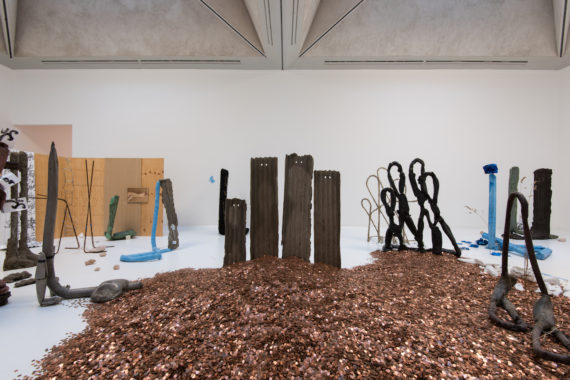Last year, when the Turner Prize was held in Glasgow, a lot of good will was generated by Assemble, the community architect-designers who proved to be a predictable win. But generating warm feelings for good works is no compensation for an award that’s grown lacklustre.
Perhaps it’s too much to expect an outstanding shortlist of artists under 50 every year? Should it be a biennial award? Or maybe the judges shouldn’t only consist of a small clique of curators whose narrow focus ensures a shortlist that often feels desiccated.
And what about that upper age limit? There are just as many ’emerging’ and ‘mid-career’ artists who are well past middle-age that the age restriction has simply outgrown its purpose – which was to keep old grandees from hogging the limelight. Just think of the late flourishing of painter Rose Wylie and sculptor Phyllida Barlow.
In fact, Barlow, who’s 72, has been nominated for a prestigious art award this year; she’s on the shortlist for the Hepworth Prize for Sculpture, a new biennial prize in which age is no barrier. Alongside her is Helen Marten, who, at 30, is the youngest artist on that shortlist. Marten also happens to be the youngest of this year’s Turner Prize nominees. And, in an amazing triple whammy, she also has a Serpentine Sackler exhibition opening this week.
Marten is the first artist you encounter at Tate Britain’s Turner Prize display. Her work is elliptical, elusive, dense and perplexing.
She presents what have been described as 3D collages using materials such as beautifully glazed ceramics, stuffed fabrics, shelving units in metal and in wood. Plastic forms in bright colours are weaved together to form an articulated, snaking mass, and there are screenprints with cryptic and elegant imagery. Disparate fragments come together to suggest something functional, or perhaps a tableau, but one that’s continually disrupted by unexpected elements.
Looking at Marten’s work feels a bit like chasing your own tail. You also think of the combines of Robert Rauschenberg, but scrubbed clean of all his dirty, paint-splattered, rugged masculinity. Here, for instance, is a doll’s house with an elegant frontage but constructed from metal sheets with sink holes and with a strange post-modern roof.
Marten joins a shortlist that hasn’t been this strong in years, so all those entrenched misgivings dissolve on impact. As well as verve and energy, there’s plenty of earthy humour.
An enormous pair of buttocks, hands spreading each cheek, greets you as you proceed to a room plastered in wallpaper that looks like brick walls. Anthea Hamilton’s towering butt dominates a room featuring a kinky boot sprouting lichen and a hanging suit that’s printed with the same brick pattern.
The playful surrealism continues with a Magritte-like cloudy blue sky painted on another set of walls, and there’s a row of metal and Perspex knickers. But the tease feels all on the surface – not much, after all, to detain you here.
Things take a gentler, slower, more evocative turn in Josephine Pryde’s display, which sees gorgeous, ghostly photograms on Ikea kitchen surfaces and rows of colour photographs of busy female hands with nails painted in striking colours. A toy train with graffiti tags bisects the room.
Lastly, we have Michael Dean’s brilliant reprisal of his South London Gallery exhibition, ‘Sic Glyphs’: in a dazzling white room, suggesting the sunlight of outdoors on a bright day by the sea, we find concrete boulders, padded pipes, sheets of painted corrugated iron, metal tubing and tiny casts of clenched fists, plus a big scattered pile of pennies in the middle of it all.
The sum totals £20,436 precisely – one penny below the official poverty line for a family of four; while the sculptures resemble family groups one moment and cursive letters the next. It’s an installation dense with allusion, rich with suggestion, and visually thrilling too. Without hesitation, I’d put all my pennies on Dean to win.
Turner Prize 2016 exhibition continues at Tate Britain until 2 January 2017. This year’s winner will be announced on 5 December at an awards ceremony broadcast live on the BBC. www.tate.org.uk
Images:
1&7: Michael Dean, Turner Prize 2016, Tate Britain. Courtesy Joe Humphrys © Tate Photography
2-3: Helen Marten, Turner Prize 2016, Tate Britain. Courtesy Joe Humphrys © Tate Photography
4-5: Anthea Hamilton, Turner Prize 2016, Tate Britain. Courtesy Joe Humphrys © Tate Photography
6&8: Josephine Pryde, Turner Prize 2016, Tate Britain. Courtesy Joe Humphrys © Tate Photography
More on a-n.co.uk:

Abstract expressionism: a phenomenon, not a movement

Estuary 2016 festival: transition, decay and the sonics of the sea

Jerwood Drawing Prize 2016: highlighting the ambiguous boundaries of the medium








